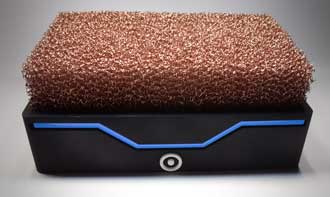 The Silent Power PC has swapped its noisy electric fans in favour of a copper afro.
The Silent Power PC has swapped its noisy electric fans in favour of a copper afro.
In place of a conventional fan, the unit uses an open-air metal foam heatsink that boasts an enormous surface area thanks to the open-weave filaments of copper. It looks like a Brillo Pad, or that the unit secretly wants to audition for the lead role in a 1970’s version of Shaft.
The Silent Power creators say that the circulation of air through the foam is so efficient in dissipating heat that the exterior surface temperature never rises above 50° C.
The rest of the kit is conventional enough. It has an Intel quad-core i7-4785T 2.2 GHz processor, 8 or 16 GB of RAM, Nivida GTX 760 graphics card, and the usual array of USB, Wi-Fi, Ethernet, HDMI, DVI, and audio ports, along with Windows 8.1 as standard
But the whole thing is kept fanless by using a copper base, which is in direct contact with the CPU and GPU via thermal paste, forms the top of the chassis and absorbs heat and releases it evenly to the copper foam on top.
The difference is that its heat dissipation is 500 times greater than that offered by conventional fin-type heatsink systems and is more than sufficient to maintain adequately low operating temperatures. The CPU and GPU are on the top of the stack, rather than in the bottom of the case to help keep it cool.
It is not a big machine either – Just 6.2x 4x 2.75 inches. It does need an external power supply but you have to lose something when you get that small.
Installed in the machine is a sensor that the team says can detect movement to wake the unit up from standby as the user approaches. Conversely, if the user leaves the proximity of the device, the sensor detects the lack of movement and automatically locks the system.
The machine is only a prototype, German startup Silent Power is running its own crowdfunding campaign with a goal of €45,000 (US$60,000) to get the unit into production.
Pre-ordering of one of three versions of the PC for $930 gets you the base 8 GB RAM, 500 GB HDD version. If you splash out $1,030 you will get the 26 GB RAM, 500 GB HDD model and the top of the range $1,550 model will have 16 GB RAM, 1,000 GB SSD PC. Of course, you will have to wait until spring of 2015 to pick it up.



















